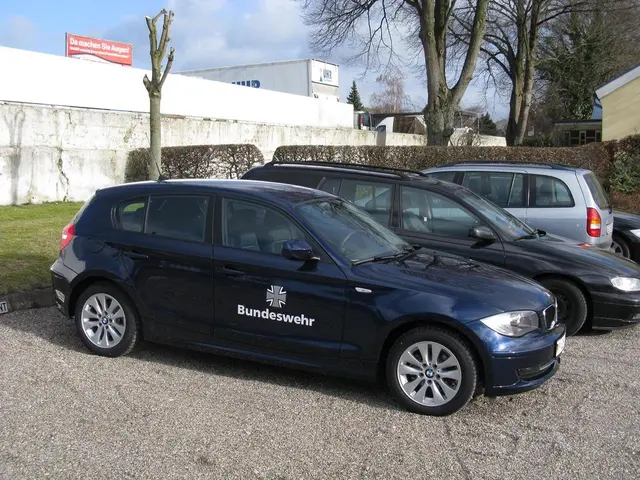AI Transforming Creative Industries: Blending Art with Artificial Intelligence
UK's Creative AI Ecosystem Thrives Amidst Global Competition
Artificial Intelligence (AI) is revolutionising the creative industries in the UK, with a dynamic and collaborative research and commercial landscape. This transformation is evident in the recent establishment of the UK Centre for Creative AI, a joint venture between academia, such as UCL and RCA, and industry partners, aiming to innovate in arts, media, fashion, music, and beyond [1].
Commercial partnerships are growing, with the UK Centre for Creative AI fostering collaborations with companies like Diageo and Unilever. Meanwhile, the UK maintains a cautious approach towards AI regulation, particularly in intellectual property (IP) protection. This stance aims to balance fostering innovation with protecting creators' rights, as seen in campaigns against unregulated AI use that may threaten creative outputs [3].
The UK's copyright framework supports protection of computer-generated works (CGWs), offering incentives for business investment in creative AI. However, the UK may face relative drawbacks compared to countries with more permissive data and AI regulations, affecting competitiveness in advanced AI research and commercial deployment [4].
Comparatively, the US and China lead in AI innovation pace and investment, benefiting from larger ecosystems and more relaxed data laws. The UK aims to leverage its regulatory caution and collaborative models to become a global AI enabler, balancing growth with ethical governance [3].
| Aspect | UK | Other Leading Countries (e.g., US, China) | |------------------------|-------------------------------------------|---------------------------------------------------------| | AI Research | Strong academic-industry collaborations; active centers like UK Centre for Creative AI[1] | Larger scale R&D investment and ecosystem, rapid innovation pace[4] | | Regulatory Approach | Cautious, regulatory lag to avoid premature laws; focus on protecting creators and enabling innovation[3] | Often faster or more permissive regulation facilitating rapid AI deployments[4] | | IP & Legal Protection | Copyright protection for creative AI works developing; ongoing debate on legal frameworks[2][3] | Some countries offer clearer data use policies and protection frameworks that may incentivize investment | | Commercial Application | Growing commercial partnerships in fashion, media, arts; support for emerging talent and startups[1] | Larger commercial markets and infrastructure supporting AI-driven creative industries[4] | | Ethical Governance | Emerging focus on Responsible AI principles and inclusive design, though investment in governance infrastructure is limited[5] | More varied; some proactive policies (e.g., Singapore) serve as international examples[5] |
In conclusion, the UK's creative AI ecosystem is rapidly developing with strategic academic-industry collaboration and careful regulatory tuning. However, it faces strong competition from countries with bigger investments and more permissive legal environments. The UK's approach emphasizes balancing innovation, creator rights, and ethical AI deployment as a potential strength in the global creative AI landscape [1][2][3][4][5].
This report was commissioned by the Creative Industries Council, detailing the results of a survey of employers in the UK's creative industries regarding their migrant and skills needs. The UK's departure from the EU has affected the way British firms trade and work with European firms. Despite these challenges, the UK remains one of the world's leading research centres in AI, with high levels of research in Generative Adversarial Networks (GANs) and a strong position in AI research in domains potentially relevant for the creative industries [6].
References:
- UK Centre for Creative AI
- Copyright and related rights for computer-generated works
- AI and the law
- AI in the UK
- Responsible AI
- Nesta's Innovation Mapping
- The UK, with its thriving creative AI ecosystem, encourages innovative skills in arts, media, fashion, music, and beyond, thanks to a dynamic research and commercial landscape.
- The UK Centre for Creative AI, a joint venture between academia and industry, is leading the charge in this sector, fostering collaborations with companies like Diageo and Unilever.
- While the UK maintains a cautious approach to AI regulation to protect creators' rights, there's a need for strategic policy development to stay competitive globally.
- Data, evidence, and talent are key resources for the UK's creative AI industries, with a strong focus on leveraging AI research, particularly in Generative Adversarial Networks (GANs).
- As the UK competes with AI powerhouses like the US and China, it emphasizes ethical AI deployment as a unique selling point, promoting responsible AI principles and inclusive design.
- The UK's departure from the EU has posed challenges for British firms engaging with European partners, but it remains one of the world's leading AI research centres.
- To maintain its competitive edge, the UK must continue its research and development efforts in AI, focusing on collaboration, policy development, and ethical AI governance.



